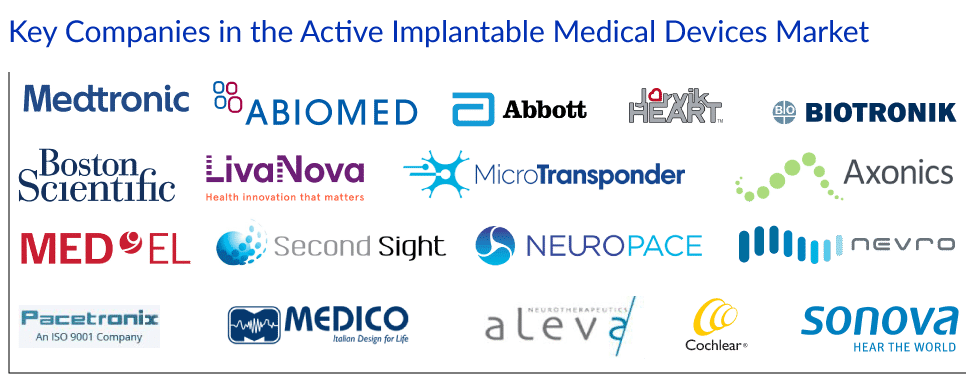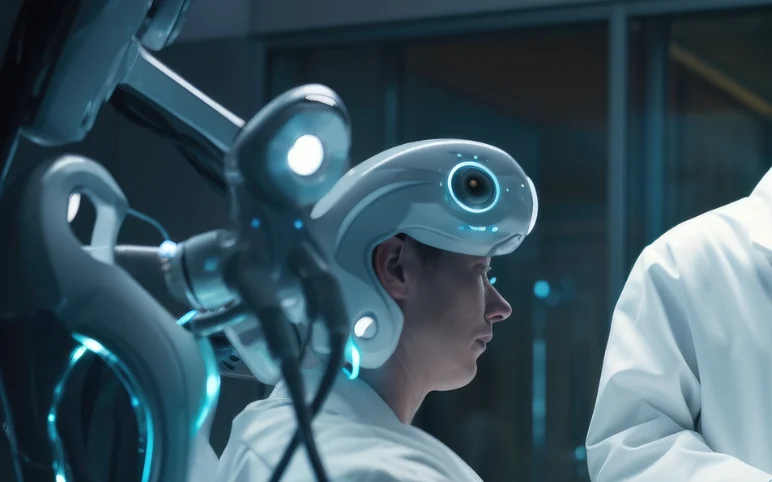How is Active Implantable Medical Devices Market Evolving?
Dec 28, 2022
Table of Contents
Over the past few years, the growth and development in electronics, micro and nano-fabrication, and wireless technology have significantly enhanced the quality and effectiveness of healthcare delivery systems, and treatment outcomes and led to various insights in the biological investigations through research and development (R&D) activities. Similarly, it has ushered an intense evolution in active implantable medical devices (AIMDs) manufacturing and their potential use by patients. Implantable medical devices are biocompatible, sensitive, and reliable devices that can be totally or partially introduced, surgically or medically, into the human body. Implantable medical devices have various applications in today’s healthcare industry; these devices have various uses, such as medical diagnosis and prognosis, therapeutic applications, and biological science studies.
As per DelveInsight’s assessment, the global active implantable medical devices market is anticipated to grow at a CAGR of 7.63% during the forecast period (2022 to 2027). A surge in the incidences of chronic disease (such as cardiovascular & neurological illnesses), technological advancements, increased awareness among the public, favorable reimbursement policy for implantation, and a rise in the investments & funds to develop technologically advanced products have led to the high growth of the active implantable medical devices market over the past few years, which is likely to stimulate the growth in the coming years further as well. Similarly, several MedTech and HealthTech giants are also working in the Active Implantable Medical Devices market to cater to different needs and to grab market share.
Downloads
Click Here To Get the Article in PDF
Recent Articles
- Agiliti Launches Essentia; KUBTEC Introduces PICASSO Plus; FDA Clears Neuvotion’s NeuStim™ for No...
- Myopia Medical Devices That Are Transforming Vision Care
- Boston Scientific’s Insertable Cardiac Monitor; Phillips-Medisize Teamed up with GlucoModicum; Bo...
- Olympus Launches New Gynecologic Power Morcellator; Journey Biosciences Launched NaviDKD; GE Boar...
- Glucotrack Secures Ethical Approval for Extended Clinical Trial of Continuous Blood Glucose Monit...
What are Active Implantable Medical Devices?
Active implantable medical devices also referred to as Active implants, are defined to be those implants that require external power to operate (excluding energy generated by gravity or the human body itself). AIMDs are intended to be totally or partially introduced, surgically or medically, into the human body or by medical intervention into a natural orifice and are intended to remain after the procedure. Active Implantable are usually powered by batteries, and in some cases, they can have a number of sensors that allow them to monitor the patient’s condition. Active implants include a wide range of devices and products that support organs and tissues, monitor bodily processes, and can also provide medication. Some of the implants are prosthetics intended to replace missing body parts. The implants may comprise skin, bone, or other body tissues and may also use metal, plastic, ceramic or other materials. Some of the most common active implants include ventricular assist systems, infusion pumps, cochlear implants, cardiac pacemakers, internal defibrillators, and neurostimulators. Implants can either be inserted permanently or removed after they are no longer required. Active implantable medical devices are usually considered to be safe; however, they can have some risks or complications.
Active Implantable Medical Devices Market Segment Analysis
Active implantable medical devices come in various sizes and shapes. These devices can be attached to a different body part of the patient and can perform various, diverse functions. As per the product types, the Active implantable medical devices are segmented as Implantable Cardiovascular Devices, Implantable Neurostimulators, Hearing Implants, and others. Implantable Cardiovascular Devices are further classified into Implantable Cardioverter Defibrillators, Ventricular Assist Devices, Implantable Pacemakers, Implantable Cardiac Monitors/Insertable Loop Recorders. Similarly, Implantable Neurostimulators are segmented as Deep Brain Stimulators, Spinal Cord Stimulators, Sacral Nerve Stimulators, and others.
As per DelveInsight’s assessment, in the Active implantable medical device’s product segment, the implantable neurostimulation product segment is anticipated to hold a noteworthy market share in the forthcoming years. Some of the key factors, such as the exponentially growing cases of neurological disorders and nerve-associated disorders such as epilepsy, migraine, Parkinson’s Disease, and others among the population across the globe, and the approval of neurostimulators for extended applications are anticipated to drive the demand for the implantable neurostimulation product, thereby stimulating the overall Active implantable medical devices market growth. As per the estimate, in the year 2019, globally, about 50 million people worldwide have epilepsy, making it one of the most common neurological diseases. Moreover, in 2020, there was about 9.4 million population suffering from Parkinson’s disease globally. Thus, the rising various neurological disorders are one of the key factors for the segmental growth of AIMDs in the upcoming years.
Active Implantable Medical Devices Benefits and Risk
The active implantable medical devices market is accelerating rapidly owing to ongoing innovation in tissue engineering, information and communication technologies, and nanoscience. With each passing day, AIMDs are becoming smaller, faster, more powerful, and becoming more and more compatible with their embedding or integration into the body. Various illnesses, including those affecting the heart, the nervous system, and even some types of cancer, can be treated using AIMDs. AIMDs are life-saving devices that healthcare professionals extensively use to help diagnose and treat patients. It has several benefits, such as improved diagnosis accuracy, early disease detection, and better treatment outcomes. Moreover, these devices hold immense potential to restore mobility and improve quality of life. Active implantable medical devices can reduce the costs of treatment and can lower the need for regular treatment or follow-ups for chronic disease.
All surgical procedures have some form of risk associated with them. Similar is the case with active implantable medical devices. AIMDs can have surgical risks during placement or removal, infection, and implant failure. Similarly, in some cases, the patients may have reactions to the materials used in implants which can lead to different types of complications such as the spread of disease, pain, swelling, or redness. Infections are common. If AIMDs are not used correctly, it could lead to errors in medication administration, which could result in serious patient harm. Similarly, the possibility of equipment malfunction and the psychological effect cannot be neglected at any point in time after the implant is done. Deep brain stimulation implants, for example, have been linked to changes in mood and behavior, with potentially broader implications on social and familial networks. Electric shocks from implantable cardioverter defibrillators can be upsetting for the patient and are found to be linked to depression, anxiety disorders, and post-traumatic stress. An in-depth assessment and study of the safety and efficacy of the implants can reduce the risk factors and adverse events associated with them.
Active Implantable Medical Devices Market Dynamics
Globally, the demand for various active implantable medical devices is growing at an immense pace due to several underlying factors. The rising prevalence of disorders majorly associated with heart, brain, and hearing loss among the old age population worldwide is one of the key factors. As per the estimate, there were an estimated 727 million persons aged 65 years and over in the year 2020, which is projected to double and reach over 1.5 billion persons by the year 2050. Over the years, intense growth has been registered in the number of companies taking an active interest in developing technologically advanced products and devices. In addition, the rise in investment and funds by the companies focused on developing active implantable medical devices is also a factor that will contribute to the active implantable devices market growth. Furthermore, the approval and the launch of devices by the regulatory authorities have also created a profitable and promising environment for the companies to work in the active implantable medical devices market actively. However, despite several favorable factors, some of the key aspects, such as the high cost of the devices along with the stringent regulatory approval process of the devices, are anticipated to impede the global active implantable medical devices market growth in the coming years. Similarly, one of the major challenges with active implantable medical devices is how long they can sufficiently and continuously operate.
Key Players in the Active Implantable Medical Devices Market and Regional Market Assessment
Some of the key market players operating in the active implantable medical devices market include Medtronic, ABIOMED., Abbott, Jarvik Heart, Inc., Biotronik SE & Co. KG, Boston Scientific Corporation, LivaNova, Inc., MicroTransponder Inc., Axonics Modulation Technologies, Inc., MED-EL Medical Electronics, Second Sight, NeuroPace, Inc., NEVRO CORP., Pacetronix.com, MEDICO S.p.A., Aleva Neurotherapeutics S.A., Cochlear Ltd., Sonova, Berlin Heart GmbH, and SynCardia Systems LLC, among others.

As per the analysis, among all the regions, North America is expected to occupy a major share in the overall active implantable medical devices market in the coming years. Some of the key factors, such as the surge in the cases of various heart-associated disorders, rise in neurodegenerative disorders, increased population with chronic pain, increasing hearing disability, obesity, cardiovascular disorder, and others, are expected to drive the active implantable medical devices market growth. Moreover, favorable reimbursement scenarios and a well-established healthcare system are further anticipated to drive the market. The North American market is a major hub for strategic business activities by the several manufacturers present in the market. There is intense competition among the key players to maintain their position in the region, thereby boosting the market for active implantable devices.
Moreover, the Asia-Pacific region is also anticipated to showcase a high growth rate in demand for AIMDs owing to the rising old age population and the high rate of various age-related disorders. Furthermore, rising government initiatives to raise awareness regarding the disorders along with their management, rising disposable income, and improving healthcare infrastructure are also anticipated to drive active implantable medical devices in the region in the upcoming years.
Recent Developmental Activities in the Active Implantable Medical Devices Market
Over the years, the active implantable medical devices market has evolved significantly owing to the active participation of global MedTech companies and technological advancements in the domain. Some of the major clinical, commercial, and regulatory developments in the AIMDs market include:
- In August 2021, MicroTransponder secured approval from the US FDA for its Vivistim Paired VNS System, a drug-free stroke rehabilitation system to treat moderate to severe upper extremity motor deficits associated with chronic ischemic stroke.
- In January 2021, Boston Scientific Corporation received FDA approval for its fourth-generation Vercise Genus™ Deep Brain Stimulation (DBS) System, which is approved for conditional use in a magnetic resonance imaging (MRI) environment and also consists of a family of Bluetooth-enabled, rechargeable, and non-rechargeable, implantable pulse generators (IPGs) that power Cartesia™ Directional Leads to provide optimal symptom relief.
- In January 2021, Boston Scientific launched WaveWriter Alpha™ Spinal Cord Stimulator Systems in the US to relieve chronic pain.
- In August 2020, Medtronic received approval from FDA for the InterStim Micro neurostimulator, and InterStim SureScan MRI leads for the treatment of bladder and bowel control conditions.
As per DelveInsight, the ongoing clinical & commercial development activities and research in the domain will contribute immensely to the allergy diagnostics market in the coming years.
Active Implantable Medical Devices – Key Analysis and Perspective
Active Implantable Medical Devices are a thriving segment in the healthcare industry. With the launch of new implants in the market, it is immensely catering to different needs. Similarly, governments are also bringing in new policies for better and more effective management of these devices while ensuring safe, effective, and equitable access. As per DelveInsight’s assessment, the global active implantable medical devices market was valued at USD 26.78 billion in 2021, and it is anticipated to reach USD 41.47 billion by 2027. Some of the key factors, such as the growing burden of various diseases such as neurological disorders, cardiovascular disorders, hearing disabilities, and others among the worldwide population due to the growing old age population, are anticipated to immensely drive the AIMDs market growth.
Moreover, the active participation of MedTech giants related to product development activities, the rise in product approvals, and the increase in investment and funds by the companies for developing active implantable devices are further anticipated to drive the market. Similarly, the emergence of connected implants is expected to provide a new dimension to the active implantable medical devices market, with enhanced patient care through data gathering and their use for diverse purposes.

Downloads
Article in PDF
Recent Articles
- Check-Cap’s Pivotal Trial for C-Scan; Curebase and Flow Neuroscience’s tDCS Device; Brainlab Acqu...
- Olympus Gains FDA Clearance for EDOF™ Imaging Endoscopes; FDA Approves Abbott’s Tendyne™ Device f...
- Pressure Relief Devices: Charting the Course of Market Evolution and Major Developments
- Savara Introduced aPAP ClearPathTM; RaySearch Released RayStation 2024A; FDA Approved Expanded La...
- Smart Inhalers: Redefining Respiratory Care with Technology and Data



